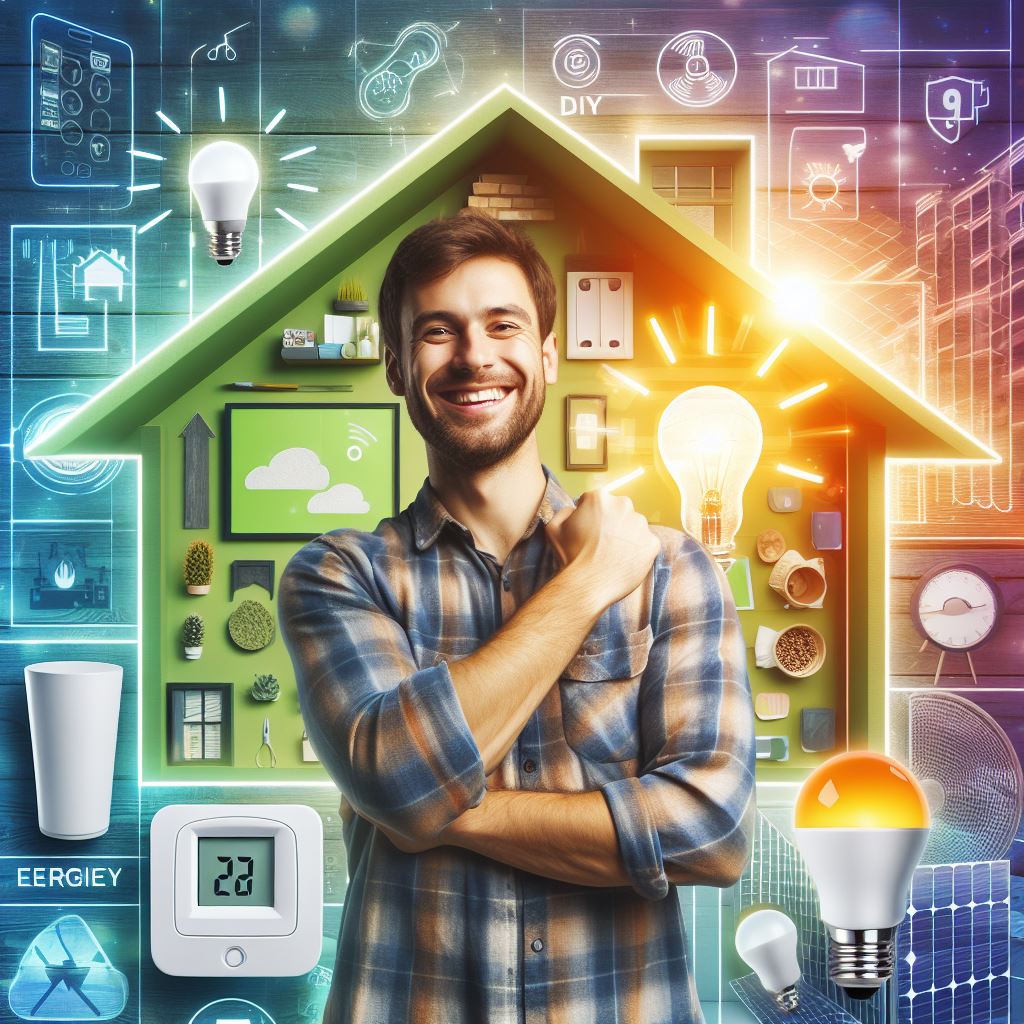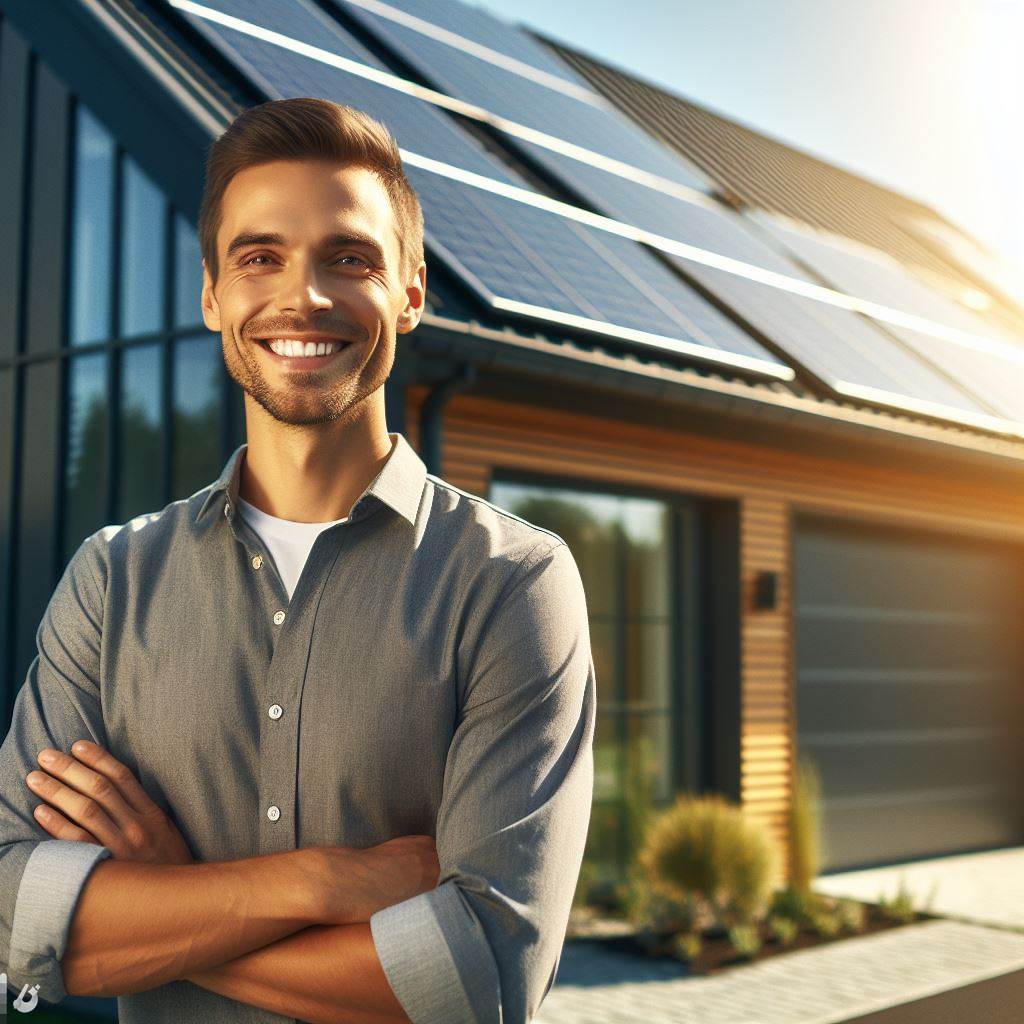Introduction
In this blog post, we will explore Energy Saving DIY Projects for Your Home.
Energy-saving projects play a critical role in today’s world, where energy consumption continues to rise at an alarming rate.
By implementing simple DIY projects, you can make a significant impact on reducing your energy usage, benefiting both your wallet and the environment.
One of the key benefits of DIY projects is the opportunity to save money.
By making energy-saving improvements to your home, such as installing insulation or weather stripping, you can lower your utility bills.
Additionally, DIY projects often cost less than hiring professionals, further increasing your savings.
Another advantage of DIY projects is the ability to improve the efficiency of your home.
By using energy-efficient light bulbs, appliances, and equipment, you can reduce your energy consumption and minimize your carbon footprint.
DIY projects also allow you to customize your home to suit your specific needs and style.
In this blog post, we will discuss various energy-saving DIY projects that you can easily tackle.
We will cover topics such as home weatherization, energy-efficient lighting, smart thermostat installation, and renewable energy solutions.
Each project will be explained in detail, providing step-by-step instructions and highlighting the potential energy and cost savings.
By the end of this blog post, you will have a comprehensive understanding of the energy-saving DIY projects available to you.
Whether you are a seasoned DIY enthusiast or a beginner, there will be projects suitable for your skill level.
Let’s get started and make our homes more energy-efficient while reducing our impact on the environment.
Assessing Energy Efficiency
Conducting a home energy assessment
Performing a home energy assessment is the first step towards discovering energy-saving opportunities in your home.
By assessing your energy efficiency, you can identify areas that require improvement and make informed decisions about implementing DIY projects.
Here are the key steps to conduct a home energy assessment:
- Inspect your insulation: Check for any gaps or damage in your insulation, especially in the attic and walls.
Inadequate insulation can lead to significant heat loss and increased energy consumption. - Examine air leaks: Detect and seal any air leaks around windows, doors, and electrical outlets using caulking or weatherstripping.
These leaks can let in cold air during winter and allow conditioned air to escape during summer, causing your HVAC system to work harder. - Evaluate lighting: Replace traditional incandescent bulbs with energy-efficient LED or CFL bulbs.
These alternatives not only consume less energy but also have a longer lifespan, reducing replacement costs. - Assess appliance efficiency: Check the energy efficiency rating of your appliances, such as refrigerators, washing machines, and dishwashers.
Consider upgrading to ENERGY STAR certified models, which are optimized for energy conservation. - Analyze heating and cooling systems: Inspect your HVAC system, including the furnace, air conditioning unit, and ductwork.
Regular maintenance, such as cleaning filters and sealing ducts, can optimize their performance and maximize energy efficiency.
Identifying areas for improvement
Once you have conducted a thorough home energy assessment, it’s time to identify specific areas that require improvement.
By targeting these areas, you can prioritize your DIY projects accordingly and achieve significant energy savings:
- Windows and doors: Upgrade to energy-efficient windows and doors that are properly sealed to prevent drafts and air leakage.
- Insulation: Enhance your insulation levels, especially in the attic and walls, to minimize heat transfer and reduce energy loss.
- Thermostat control: Install a programmable thermostat to regulate temperature settings based on your daily schedule.
This will prevent unnecessary heating or cooling when you’re away from home. - Water heating: Insulate your water heater and consider installing low-flow showerheads and faucet aerators to reduce hot water usage.
- Renewable energy sources: Explore options like solar panels or wind turbines to generate your electricity, reducing your reliance on traditional power grids.
Understanding energy-saving goals
Setting energy-saving goals is essential to ensure the success of your DIY projects and maintain long-term energy efficiency.
Consider the following factors when defining your goals:
- Financial savings: Calculate the potential energy cost savings that each project can bring.
Determine the return on investment and prioritize projects with shorter payback periods. - Environmental impact: Evaluate the environmental benefits of reducing your energy consumption, such as lowering greenhouse gas emissions and promoting sustainability.
- Comfort and well-being: Consider the impact of energy-saving improvements on your overall comfort and well-being.
Proper insulation and efficient heating/cooling systems can create a more comfortable living environment. - Long-term maintenance: Assess the maintenance requirements of each project.
Opt for solutions that are easy to maintain and provide lasting energy efficiency benefits.
By conducting a home energy assessment, identifying areas for improvement, and understanding your energy-saving goals, you can embark on effective and rewarding DIY projects that will make your home more energy-efficient.
Empower yourself with the knowledge and resources necessary to reduce your energy consumption while positively impacting your household’s budget and the environment.
Read: DIY Basics: Installing Your Own Lighting
Weatherproofing and Insulation Projects
Weatherproofing and insulation projects are essential for creating an energy-efficient home.
By sealing air leaks, adding insulation, installing weatherstripping, and utilizing window films, you can significantly reduce your energy consumption and save money on utility bills.
Sealing air leaks
One of the most effective ways to improve energy efficiency is by sealing air leaks around your home.
Use caulk to seal gaps around windows, doors, and electrical outlets. Weatherstripping can be used for larger gaps around windows and doors.
Remember to check the attic for any openings or gaps that may be letting in air.
Seal these areas as well to prevent heat loss in the winter and heat gain in the summer.
Adding insulation in the attic and walls
Poor insulation is a major cause of energy waste.
Adding insulation in the attic and walls can help maintain a comfortable temperature inside your home and reduce the workload on your heating and cooling systems.
Start by insulating the attic with fiberglass batts or blown-in insulation. Make sure to cover all areas, including the eaves and access points.
For the walls, consider using foam insulation or cellulose insulation, which can be blown into the wall cavities.
Installing weatherstripping and door sweeps
Weatherstripping and door sweeps are simple and affordable ways to prevent drafts and improve energy efficiency.
Use weatherstripping on doors and windows to seal gaps and prevent air leakage.
Install door sweeps at the bottom of exterior doors to block drafts and keep cold air from entering your home.
These small additions can make a big difference in maintaining a comfortable indoor temperature.
Utilizing window films and coverings
Windows are a significant source of energy loss in many homes.
Utilizing window films and coverings can help reduce heat gain in the summer and heat loss in the winter.
Window films can be applied to the interior of windows to reflect heat away from the house during hot months and retain heat inside during cold months.
They are easy to install and offer a cost-effective solution to improve energy efficiency.
Additionally, using thick curtains or blinds can provide an extra layer of insulation.
Close them during the night to prevent heat loss and open them during the day to let natural light and warmth in.
In fact, weatherproofing and insulation projects are vital for maximizing energy savings in your home.
By sealing air leaks, adding insulation, installing weatherstripping, and utilizing window films and coverings, you can create a more energy-efficient and comfortable living environment while saving money on your energy bills.
Upgrading Lighting Systems
Replacing traditional bulbs with energy-efficient LEDs
- LEDs consume less energy and last longer than traditional incandescent bulbs.
- By switching to LEDs, you can save up to 75% on lighting costs.
- LEDs are available in various colors and sizes, making them suitable for any room.
- They produce less heat, reducing the strain on your air conditioning system.
- Installing dimmable LEDs allows you to adjust the lighting according to your needs.
Installing motion sensor or smart lighting controls
- Motion sensors can automatically turn off lights when no one is present in the room.
- By using smart lighting controls, you can easily program lighting schedules.
- Smart controls also enable remote access, allowing you to turn off lights when you’re away.
- This technology ensures that lights aren’t left on unnecessarily, saving energy.
- It increases convenience by eliminating the need to manually turn lights on and off.
Maximizing natural light through proper window treatments
- Choose lighter colors for your curtains or blinds to reflect more natural light.
- Using sheer curtains or blinds can filter sunlight and reduce the need for artificial lighting.
- Install windows with low-emissivity (low-e) glass to minimize heat gain and maximize natural light.
- Position furniture to allow the penetration of sunlight deeper into the room.
- Clean windows regularly to ensure maximum natural light enters your home.
Upgrading your lighting systems not only saves energy but also enhances the overall ambiance of your home.
By replacing old bulbs with energy-efficient LEDs, you can reduce electricity consumption and lower your utility bills.
Motion sensor and smart lighting controls enable automated lighting, ensuring lights are only used when needed.
Maximizing natural light through window treatments not only reduces reliance on artificial lighting but also improves the aesthetics of your home.
Consider implementing these energy-saving DIY projects to make your home more environmentally friendly and cost-efficient.
Read: Eco-Friendly DIY Home Upgrades to Try
Energy-Efficient Appliances and Electronics
Upgrading to ENERGY STAR certified appliances
Replace old appliances with ENERGY STAR certified models to save energy and reduce utility bills.
ENERGY STAR appliances use less energy and water, helping the environment while maintaining performance.
Look for the ENERGY STAR label when purchasing refrigerators, dishwashers, washing machines, and other home appliances.
These appliances may cost slightly more upfront, but the long-term savings make them a worthwhile investment.
Appliances like refrigerators and air conditioners account for a significant portion of a household’s energy consumption.
By upgrading to ENERGY STAR certified options, you can decrease your energy usage by up to 50% in some cases.
Additionally, ENERGY STAR appliances often come with additional benefits like improved performance and durability.
Optimizing power usage of electronics
- Unplug electronic devices when not in use to eliminate standby power consumption.
- Use power strips for multiple gadgets and turn them off when you’re not actively using them.
- Adjust the power settings on your computer and monitor to reduce energy consumption.
- Enable power-saving features like sleep mode or screen savers that turn off the display after a certain period of inactivity.
- Avoid leaving chargers plugged in when not in use, as they continue to draw power even without a device attached.
- Choose energy-efficient models when shopping for new electronics, such as LED TVs or low-power desktop computers.
- Consider using a laptop instead of a desktop computer since they generally consume less energy.
Installing smart thermostats for efficient heating and cooling
- Replace traditional thermostats with smart thermostats, which can help optimize your HVAC system’s energy usage.
- Smart thermostats allow you to program heating and cooling settings based on your schedule.
- Some models even have learning capabilities, adapting to your preferences and adjusting temperatures accordingly.
- Take advantage of features like geofencing, where the thermostat adjusts settings based on your proximity to home.
- Remote access via smartphone apps lets you control your thermostat even when you’re away, avoiding unnecessary energy usage.
- Utilize zoned heating and cooling to customize temperatures in different areas of your home.
- Smart thermostats provide detailed energy usage reports, allowing you to identify further ways to save energy.
By upgrading to ENERGY STAR certified appliances, optimizing power usage of electronics, and installing smart thermostats, you can significantly reduce your home’s energy consumption.
These energy-saving initiatives not only benefit the environment but also save you money on utility bills.
Make a conscious effort to implement these changes in your home and enjoy the long-term benefits of energy efficiency.
Read: Tiny Home Total Makeover: See the Stunning Change!

Harnessing Renewable Energy
Installing solar panels
Switching to solar panels is an excellent way to harness renewable energy and save money on your electricity bill.
Solar panels convert sunlight into usable electricity, reducing your dependence on fossil fuels.
Solar panels work by capturing sunlight using photovoltaic cells and converting it into direct current (DC) electricity.
This DC electricity is then converted to alternating current (AC) to power your home.
Installing solar panels requires careful consideration of your home’s location, roof orientation, and shading.
Benefits of installing solar panels
- Lower electricity bills: Solar panels can significantly reduce or even eliminate your electricity bills, depending on your energy usage and the size of the system.
- Tax incentives and rebates: Many governments offer incentives, such as tax credits and rebates, to encourage the installation of solar panels.
- Environmental benefits: Solar panels generate clean, renewable energy, reducing greenhouse gas emissions and your carbon footprint.
Investing in wind turbines or geothermal systems
Wind turbines and geothermal systems are alternative options for harnessing renewable energy.
While solar panels are more common, these technologies have their own advantages and can be suitable for certain locations.
Wind turbines
Wind turbines generate electricity by converting the kinetic energy of the wind into mechanical power.
This power is then converted into electricity using a generator.
Considerations when investing in wind turbines include local wind resources, noise levels, and zoning restrictions.
Benefits of wind turbines
- Constant energy production: Wind turbines can generate electricity even at night or during cloudy days when solar panel efficiency may be reduced.
- Potential for excess energy: If your wind turbine generates more electricity than your home needs, you can sell it back to the grid.
- Environmental benefits: Wind energy is clean and renewable, reducing reliance on fossil fuels and mitigating climate change.
Geothermal systems
Geothermal systems utilize the earth’s natural heat to provide heating, cooling, and hot water for your home.
They use a series of pipes buried underground to transfer heat to and from the earth.
Benefits of geothermal systems
- Energy efficiency: Geothermal systems can be up to four times more efficient than traditional heating and cooling methods, reducing energy consumption and costs.
- Long lifespan: Geothermal systems typically last 20 to 25 years, with the ground loops lasting even longer.
- Environmental benefits: Geothermal systems produce no emissions and have a minimal impact on the environment.
In general, harnessing renewable energy through solar panels, wind turbines, or geothermal systems can provide numerous benefits for homeowners.
Not only does it reduce dependence on fossil fuels, but it also lowers electricity bills, offers tax incentives, and has positive environmental impacts.
Consider exploring these energy-saving DIY projects to make your home more sustainable and cost-effective.
Read: DIY Outdoor Spaces: Patios and Decks
Water Conservation Measures
Upgrading to low-flow fixtures
Upgrading to low-flow fixtures is a simple yet effective way to conserve water in your home.
These fixtures, such as low-flow toilets, faucets, and showerheads, are designed to reduce water usage while still providing adequate water pressure.
By installing low-flow fixtures, you can significantly decrease your water consumption.
For example, a standard toilet can use up to 3.5 gallons per flush, while a low-flow toilet typically uses 1.6 gallons or less.
Similarly, a regular showerhead can use around 2.5 gallons of water per minute, whereas a low-flow showerhead uses around 1.5 gallons per minute.
Not only will upgrading to low-flow fixtures save you water, but it will also save you money on your water bills.
Since less water is being used, you will see a decrease in your monthly water expenses.
Installing rainwater harvesting systems
Another great way to conserve water is by installing a rainwater harvesting system. This system collects rainwater from your roof and stores it for later use.
Utilizing rainwater for tasks like watering plants or cleaning can significantly reduce your dependence on municipal water supply.
Rainwater harvesting systems can be as simple as installing rain barrels or as complex as creating underground cisterns.
The collected rainwater can be used for irrigation, washing cars, or even flushing toilets.
This not only conserves water but also reduces the strain on local water resources.
Inspecting and repairing water leaks
Water leaks are not only wasteful but can also cause damage to your property.
Regularly inspecting and repairing water leaks can help conserve water and prevent costly repairs.
Start by checking all faucets, toilets, and pipes for any signs of leaks. Even a small drip can waste a significant amount of water over time.
Replace any faulty parts or apply pipe tape to fix minor leaks.
Additionally, check your water meter before and after a two-hour period without using any water.
If the meter reading has changed, it indicates a hidden leak, and you should call a plumber for further investigation.
By taking these water conservation measures, you can make a significant impact on reducing your water consumption.
Upgrading to low-flow fixtures, installing rainwater harvesting systems, and repairing water leaks are all simple yet effective ways to make your home more water-efficient.
Remember, every drop counts when it comes to conserving our precious water resources.
Start implementing these measures today and make a positive change for the environment and your wallet.
Green Landscaping
Achieving an energy-efficient home doesn’t stop at the walls.
Your outdoor space also plays a significant role in reducing energy consumption and minimizing environmental impact.
By implementing sustainable gardening practices, using native plants and drought-resistant landscaping, and installing a drip irrigation system, you can create a green and eco-friendly landscape for your home.
Implementing Sustainable Gardening Practices
- Start by composting your kitchen scraps and yard waste to create organic fertilizer.
- Avoid using chemical pesticides and opt for natural methods like companion planting and insect-repelling herbs.
- Practice water conservation by using a rain barrel to collect rainwater for your plants.
- Choose organic and locally sourced seeds and plants to reduce the carbon footprint associated with transportation.
- Create a wildlife-friendly habitat by providing food, water, and shelter for birds, butterflies, and other beneficial insects.
- Implement proper soil management techniques, such as mulching, to retain moisture and improve soil quality.
- Regularly maintain and prune your plants to ensure their optimal health and reduce waste.
Using Native Plants and Drought-Resistant Landscaping
- Native plants are adapted to the local climate, requiring less water, fertilizer, and maintenance.
- Consider using native grasses, shrubs, and trees that thrive in your region without excessive watering.
- Group plants with similar water requirements together to create efficient watering zones.
- Use groundcovers to minimize soil erosion and reduce evaporation from the soil surface.
- Incorporate hardscaping elements like gravel paths and rocks to reduce the need for water-intensive lawns.
- Install shade trees strategically to provide natural cooling for your home and reduce energy usage.
- Choose low-maintenance landscaping materials like permeable pavers to minimize water runoff and reduce heat island effect.
Installing a Drip Irrigation System
- A drip irrigation system delivers water directly to the roots of plants, minimizing wastage and maximizing efficiency.
- It provides a slow and steady water supply, reducing evaporation and allowing plants to absorb moisture effectively.
- Drip irrigation systems can be automated and controlled, ensuring plants receive the right amount of water at the right time.
- By reducing water usage, drip irrigation systems can significantly lower your outdoor water consumption and related costs.
- They eliminate overspray and runoff, preventing water wastage and protecting your landscape from soil erosion.
- Drip irrigation systems can be customized to meet specific plant watering requirements, ensuring optimal growth and health.
- With proper maintenance, these systems can last for years and contribute to long-term water conservation efforts.
By implementing sustainable gardening practices, using native plants and drought-resistant landscaping, and installing a drip irrigation system, you can create a green and energy-efficient landscape for your home.
Not only will you reduce your environmental impact, but you will also enjoy a beautiful and thriving outdoor space that complements your energy-saving DIY projects indoors.
DIY Energy Monitoring
Using energy monitoring devices or smart meters
Energy monitoring devices and smart meters are convenient tools that can be used to track your energy consumption.
By understanding how much energy you are using, you can identify areas for improvement and make changes to reduce your energy consumption and save money.
Energy monitoring devices
Energy monitoring devices are small gadgets that can provide real-time information about your energy usage.
These devices are usually easy to install and can be connected to your electrical panel or plugged into individual outlets.
They can monitor the energy usage of specific appliances or your entire home.
Smart meters
Smart meters are advanced versions of traditional utility meters that measure and record your electricity usage more accurately.
They provide detailed information about your energy consumption, including peak usage times, and can transmit data directly to your energy provider.
Tracking energy consumption and identifying areas for improvement
Once you have set up your energy monitoring device or smart meter, you can start tracking your energy consumption.
This will help you identify areas where you can make changes to reduce your energy usage and make your home more energy-efficient.
Monitor real-time data
Using the energy monitoring device or accessing the data provided by your smart meter, you can monitor real-time data of your energy consumption.
This will allow you to see how your energy usage fluctuates throughout the day and identify peak usage periods.
Identify energy guzzlers
By analyzing the data collected from your energy monitoring system, you can identify appliances or areas in your home that consume excessive energy.
These energy guzzlers may include old appliances, inefficient lighting, or poor insulation.
Set energy-saving goals
Once you have identified the areas where energy consumption is high, you can set energy-saving goals.
These goals can be as simple as reducing the time your air conditioner or heater is running or replacing old appliances with energy-efficient models.
Make necessary changes
To achieve your energy-saving goals, you may need to make some changes in your daily routines or invest in energy-efficient upgrades.
For example, you can adjust your thermostat settings to reduce energy consumption or install LED lights to replace traditional incandescent bulbs.
Monitor progress
Continuously monitoring your energy consumption allows you to see the impact of the changes you’ve made.
Keep track of your energy usage over time and compare it to previous months or years. This will help you assess the effectiveness of your energy-saving efforts.
Educate and involve your household
Energy monitoring can be a family project. Educate your household members about the importance of energy efficiency and involve them in finding ways to reduce energy consumption.
This will not only help you save energy but also create a sense of responsibility towards the environment.
In a nutshell, DIY energy monitoring is an effective way to track your energy consumption and identify areas for improvement.
By using energy monitoring devices or smart meters and analyzing the collected data, you can set energy-saving goals, make necessary changes, and monitor your progress over time.
These efforts will not only reduce your energy bills but also contribute to a more sustainable future.
Conclusion
Recap of Energy-Saving DIY Projects Discussed
Let’s revisit the energy-saving triumphs: LED swaps, sealing leaks, smart thermostats, and efficient appliances. Each project, a beacon of eco-wisdom.
Bask in the glow of LED lights, cutting energy use by 75%. Seal leaks—tiny saboteurs—locking warmth in, slicing bills down.
Smart thermostats, the maestros of temperature, orchestrating efficiency. Upgrade appliances to energy sippers; watch costs plummet.
Encouragement to Take Action and Make a Positive Impact
Now, champions of the green frontier, it’s your turn! Transform your home into an energy-saving haven.
Be the change, reduce your carbon footprint, and dance with sustainability.
In your hands lies the power to forge a brighter, greener future. Embrace these DIY projects; let your home echo with the whispers of environmental responsibility.
Small actions, colossal impact. You’ve got this.
Tips for Seeking Professional Help When Needed
Should the DIY path grow thorny, fear not. Seek the expertise of professionals. HVAC wizards, energy auditors, and eco-friendly architects await your call.
They’ll fine-tune your efforts, ensuring maximum energy efficiency.
Sometimes, a skilled touch is the catalyst needed for a sustainable revolution. Collaborate with experts; let them weave their magic.
Your home, an epitome of energy efficiency, awaits their transformative touch.
In the realm of energy conservation, every step counts. DIY endeavors empower, but professional assistance refines.
Blend both for an unstoppable force against energy waste. Together, we forge a sustainable legacy—one home at a time.




